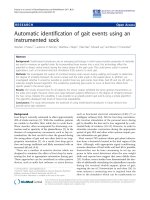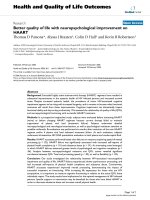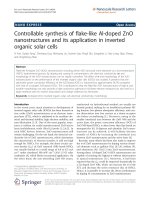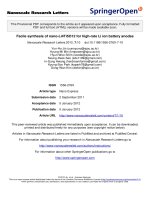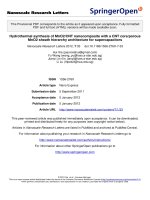Báo cáo hóa học: " One-step synthesis of PbSe-ZnSe composite thin film Seishi Abe" doc
Bạn đang xem bản rút gọn của tài liệu. Xem và tải ngay bản đầy đủ của tài liệu tại đây (1.2 MB, 6 trang )
NANO EXPRESS Open Access
One-step synthesis of PbSe-ZnSe composite thin
film
Seishi Abe
Abstract
This study investigates the preparation of PbSe-ZnSe composite thin films by simultaneous hot-wall deposition
(HWD) from multiple resources. The XRD result reveals that the solubility limit of Pb in ZnSe is quite narrow, less
than 1 mol%, with obvious phase-separation in the composite thin films. A nanoscale elemental mapping of the
film containing 5 mol% PbSe in dicates that isolated PbSe nanocrystals are dispersed in the ZnSe matrix. The optical
absorption edge of the composite thin films shifts toward the low-photon-energy region as the PbSe content
increases. The use of a phase-separating PbSe-ZnSe system and HWD techniques enables simple pro duction of the
composite package.
Introduction
Quantum-dot solar cells have attracted much attention
because of their potential to increase conversion effi-
ciency [1]. Specifically, the optical-absorption edge of a
semiconduct or nanocrystal is often shifted due to the
quantum-size effect. The optical band gap can then be
tuned to the effective energy region for absorbing maxi-
mum intensity over the solar radiation spectrum.
Furthermore, quantum dots produce multiple electron-
hole pairs per photon through imp act ionization,
whereas bulk semiconductors produce one electron-hole
pair per photon.
Wide-gap semiconductor sensitized by quantum dot is
a candidate material for such use. The quantum dot
supports absorbing visible and near-infrared light. Up to
now, various nanocrystalline materials (InP [2], CdSe
[3], CdS [4,5], PbS [6], and Ge [7]) have been investi-
gated as t he sensitizer for TiO
2
. Alternatively, a wide-
gap semiconductor ZnO is also investigated, since the
band gap and the energetic position of the valence band
maximum and conductio n band minimum of ZnO are
very close to that of TiO
2
[8]. Most of these composite
materials were synthesized through chemical techniques,
however, physical deposition, such as sp uttering, is also
useful. In the material design for co-sputtering, based
on the heat of formation, nanocrystal and matrix are
clearly phase-separated in spite of the co-deposition
from multiple sources [9,10]. However, it is generally
found that sputtering techniques often damage a film
due to contamination of the fed gas and high-energy
bombardment of the film surface. Thermal evaporation
in a high-vacuum atmosphere seems to be better as a
preparation technique from the point of view of film
quality. In addition, the present study focuses on the
insolubility of the material system, since simultaneous
evaporation from multiple sources often provides a solid
solution [11]. The PbSe-ZnSe system is a candidate for
the composite. In the bulk thermal equilibrium state,
the mutual solubility range is quite narrow, less than
1 mol%, at temperatures below 1283 K [12]. In addition,
a composite thin film of PbSe nanocrystal embedded in
ZnSe matrix is capable of exhibiting the quantum size
effect because of the relatively large exciton Bohr radius
of 46 nm in PbSe [13] and the relatively wide band gap
of 2.67 eV in ZnSe [14]. Hence, the optical gap of PbSe
nanocrystals will probably be tuned to the maximum
solar radiation spectrum. The dendritic PbSe nanostruc-
ture [15] and ZnSe nanobelt array [16], for instance, are
hitherto investigated, but th ere is no report for one-step
synthesis of PbSe-ZnSe composite thin film. Further-
more, an evaporation technique should be ca refully
selected, since the techniques involving a thermal non-
equilibrium state, such as molecular beam epitaxy,
increase the solubility limit [17]. The use of hot-wall
deposition (HWD), which can provide an atmosphere
near thermal equilibrium, is therefore indicated here
[18]. Based on these considerations, one-step synthesis
Correspondence:
Research Institute for Electric and Magnetic Materials, Sendai 982-0807,
Japan
Abe Nanoscale Research Letters 2011, 6:324
/>© 2011 Abe; licensee Springer. This is an Open Access article distributed under the terms of the Creative Commons Attribution License
( which permits unrestricted use, distribution, and reproduction in any medium, provided
the original work is properly cited.
of a PbSe-ZnSe composite thin film was investigated by
simultaneous HWD from multiple sources for the first
time.
Experimental details
A PbSe-ZnSe composite thin film was prepared by the
HWD method. Figure 1 is a schematic diagram of the
HWD apparatus used. There were four electric furnaces
in the apparatus, designated as substrate, wall, source-1,
and source-2. Each temperature could be controlled
independently. In the HWD method, deposition and
re-evaporation are continuously repeated upon a film
surface, resulting in achieving a state near thermal equi-
librium [18]. PbSe and ZnSe were used as evaporation
sources and were synthesized from elements of Pb, Zn,
and Se with 6 N purity. The PbSe and ZnSe sources
were located at furnaces of source-2 and source-1 for
simultaneous evaporation to a glass substrate (Corning
#7059). Here, the temperatures were kept constant at
573 K f or the substrate, 773 K for the wall, and 973 K
for source-1 (ZnSe). The source-2 (PbSe) temperature
was varied from 763 to 833 K to provide different PbSe
concentrations. The Pb Se-ZnSe composite thin film was
structurally characterized using X-ray diffraction (XRD)
with Cu Ka radiation (Rigaku RAD-X). A symmetric
θ-2θ configuration was used. The optical absorption
spectrum of the film was observed using a UV-vis-IR
spectrometer (Shimadzu UV5300). The composition of
the film was analyzed using energy dispersive spectro-
scopy (EDX model: Phoenix). The film was directly
observed by transmission electron microscopy (TEM)
operating at 300 kV (Hitachi H-9000NA R). In the sam-
ple preparation, mechanical polishing, dimpling, and ion
milling were performed. Nanoscale elemental mapping
was performed using scanning transmission electron
microscopy (STEM, Hitachi HD-2700) in EDX mode
(EDAX model: Genesis) operating at 200 kV with an
energy resolution of approximately 145 eV.
Results and discussion
The bulk PbSe-ZnSe phase diagram is now revealed at
ZnSe concentrations below 45 at.% (Pb-rich side) [12],
although the phase diagram of the Zn-rich side still
remains unclear. Powder synthesis of a PbSe-ZnSe sys-
tem was investigated prior to investigating the film pre-
paration. Figure 2 depicts the powder XRD pattern of
the Zn
1-x
Pb
x
Se system. In the powder synthesis, the
bulk PbSe and ZnSe thus synthesized was used as start-
ing materials. The desired composition of the s ystem
was prepared in an agate mortar and vacuum-sealed in
a quartz tube for heat treatment at 1273 K for 48 h.
Finally, the samples were successively water-quenched
to maintain the solubility range at a synthesis tempera-
ture then crushed into powder for the following experi-
ment setup. At x = 0, all of the XRD peaks are assigned
to the zinc-blend structure of ZnSe, with a lattice con-
stant of 0.5669 nm, estimated from the XRD peaks in a
high-2θ range from 100° to 155°, using the Nelson-Riley
function [19]. The XRD peak of PbSe with an NaCl
structure appears at Pb concentrations exceeding 0.02.
The lattice constant of the ZnSe at x =0.02isthesame
as at x = 0, within the precision of the experiment tech-
nique. This result indicates that the solubility range of
Pb in ZnSe is negligible. In contrast, the lattice constant
of PbSe is estimated to be 0.6121 nm at x =1.0and
0.6117 nm at x = 0.98. A slight decrease in the lattice
constant is seen in PbSe, due to the difference in ionic
radiiofPbandZn.WeakXRDpeaksofZnSearealso
Figure 1 HWD apparatus used in the study. It consists of four
electric furnaces for substrate, wall, source-1, and source-2.
Figure 2 XRD pattern of powder-synthesized Zn
1-x
Pb
x
Se with
respect to x. Dots indicate PbSe and circles indicate ZnSe.
Abe Nanoscale Research Letters 2011, 6:324
/>Page 2 of 6
observed at x = 0.98 as seen in the inset for easier view-
ing. This result indicates that the solubility range of Zn
in PbSe is less than 0.0 2 at 1273 K. The result is i n
good agreement with the previous result [12]. The phase
separation of the PbSe-ZnSe system is thus also seen on
the Zn-rich side in the thermal-equilibrium state. The
film preparation for PbSe-ZnSe composite is next inves-
tigated based on these results.
The two sources were simultaneously evaporated to
prepare a PbSe-ZnSe composite thin film. In the appara-
tus used, thermal radiation from the wall- and the
source-furnace induced an unintentional increase of
the substrate temperature up to 51 5 K without use of the
substrate-furnace. The deposition rate of the film was
almost the same irrespective of the substrate temperature
in the rang e from 515 to 593 K. A homogen eous color is
observed visually in these films. Above a substrate tem-
perat ure of 593 K, the deposition rate abruptly decreased
with inc reasing temperature, since re-evaporatio n of
PbSe from the film surface became dominant. The f ilms
visually exhibit an inhomogeneous yellowish and metallic
color, probably caused by a significant reduction in the
PbSe while the ZnSe remained, due to the relatively high
vapor pressure of PbSe [20]. The wall temperature also
induced similar behavior. A substrate temperature of
573 K and a wall temperature of 773 K are therefore
adopted throughout the present study.
Figure 3 depicts the XRD pattern for the PbSe-ZnSe
composite thin films. The weak XRD peak of PbSe at
1 mol% is enlarged in the inset for easier viewing. At a
PbSe concentration of 0 mol% (i.e., pure ZnSe), poly-
crystalline ZnSe with a zinc-blend structure is observed,
with PbSe phase appearing at concentrations exceeding
1 mol%. The solubility range of Pb in ZnSe is therefore
found to be quite narrow, less than 1 mol%, correspond-
ing well to the bulk result (Figure 2). The composite
films thus deposite d on a glass substrate exhibit a rea-
sonably polycrystalline structure , but dominant (11 1)
growth is seen in the ZnSe phase irrespective of x.At1
mol%, the lattice constant at the PbSe (220) peak is esti-
mated to be 0.6118 nm, close to that of the bulk result
(Figure 2). This result sug gests that there is also a nar-
row solubility range on the Pb-rich side. The phase-
separating PbSe-ZnSe system is therefore maintained
not only in the bulk product, but also in the film thus
obtained, despite the simultaneous evaporation from
multiple sources. This result demonstrates that an atmo-
sphere near thermal equilibrium was achieved in the
HWD apparatus used.
Figure 4a presents a bright-field TEM image of the
PbSe-ZnSe composite thin film containing 5 mol% PbSe.
Dark isolated grains with sizes o f 25 to 50 nm are se en
dispersed along the grain boundary of t he bright area.
Figure 4b-e present s an STEM-EDX elemental mapping
of the sample through X-ray detection of Zn K (red), Se
K (blue), and Pb L (green). Similar morphology is also
seen in the bright-field STEM image (Figure 4b)). The
dark grains indicate the absence of elemental Zn (Figure
4c) and the presence of Se and Pb (Figure 4d, e). It is
thus determined that the dark grains are nanocrystalline
PbSe. The other region is widely covered with the ele-
ments Zn a nd Se (Figure 4c,d), reasonably assumed to
compose ZnSe. It is therefore determined that isolate d
PbSe nanocrystals are dispersed in the ZnSe matrix. The
nanocrystals are estimated to be sufficiently small to
exhibit the quantum-size effect because of the exciton
Bohr radius of 46 nm in PbSe [13].
Figure 5 depicts optical absorption spectra for the
PbSe-ZnSe composite thin films. For comparison, the
spectrumofapureZnSethinfilmisalsopresentedin
the figure. PbSe and ZnSe have direct band structures
[21,22], and an intact absorbance is employed here to
exactly evaluate the absorption edge. At a 0 mol% PbSe,
the optical absorption edge of ZnSe is clearly observed
at 2.7 eV. Weak absorption then broadly appears at a
PbSe concentration of 1 mol% in the visible region,
together with the optical absorption edge of ZnSe. Such
multiple absorptions are also seen in the spectra at con-
centrations up to 7 mol%, indicating the obvious phase
separation of the PbSe-ZnSe system. The broad absorp-
tion edge shifts toward the lower-energy region as the
PbSe content incre ases. In particular, onset absorption
can be confirmed at approximately 1.0 eV at 16 mol%
PbSe, favorably covering the desirable energy regio n for
high conversion efficiency [23]. Therefore, it should be
noted that the PbSe-ZnSe composite thin film exhibits
the valuable characteristic of vis-NIR absorption. How-
ever, it is unclear whether the shift of the optical
Figure 3 XRD pattern of the PbSe-ZnSe co mposit e thin fi lms.
Dots indicate PbSe and circles indicate ZnSe.
Abe Nanoscale Research Letters 2011, 6:324
/>Page 3 of 6
absorption edge is due to the PbSe nanocrystals, since
the mean grain size of the PbSe remains almost the
same at 27 nm irrespective of the PbSe content, accord-
ing to the XRD result (Figure 3) using Scherrer’sequa-
tion [24]. The minimal appearance of infrared
absorption at 16 mol% PbSe strongly suggests that rela-
tively large-scale PbSe grains are partially involved in
the composite film, since the energy band gap of bulk
PbSe is 0.27 eV [22]. A nother TEM image also indicates
the presence of relatively large PbSe crystals of
Figure 4 Direct observation of PbSe-ZnSe composite thin film containing 5 mol% PbSe. (a) Bright-field TEM image. (b) Bright-field image
of STEM mode. (c) Elemental mapping of Zn (red), (d) Se (blue), and (e) Pb (green).
Abe Nanoscale Research Letters 2011, 6:324
/>Page 4 of 6
approximately 100 nm, even with a small amount of
5 mol% PbSe (not shown here). Hence, the mean grain
size of the PbSe is bimodally distributed in the compo-
site. These large-scale PbSe grains probably dominate
the full width at half max imum value of the XRD peak,
resulting in no obvious relation between the optical
absorption shift and the PbSe grain size. The size con-
trol of the nanocrystalline PbSe is therefore insufficient
in the present study. The substrate temperature thus
adopted seems to assist in the aggregation of PbSe
nanocrystal s. However, a one-step synthesis of the com-
posite package has the potential to lead to low-cost pro-
duction of next-generation solar cells.
Conclusion
We investigated the preparation of PbSe-ZnSe compo-
site thin films by a co-evaporating HWD method. The
relatively high substrate and wall temperatures induce
re-evaporation of PbSe from the substrate surface while
the ZnSe remains. The solubili ty limit of Pb in ZnSe is
quite narrow, less than 1 mol% in the film form, indicat-
ing that an atmosphere near thermal equilibrium is
achieved in the apparatus used. Elemental mapping indi-
cates that isolated PbSe nanocrystals are dispersed in the
ZnSe matrix. The optical absorption edge shifts toward
the lower-photon-energy region as the PbSe content
increases. In particular, onset absorption can be con-
firmed at approximately 1.0 eV with 16 mol% PbSe,
favorablycoveringthedesirableenergyregionforhigh
conversion efficiency. The insolubility material system
and the HWD technique enable a one-step synthesis of
PbSe-ZnSe c omposite thin film. Further investigation is
needed to produce a narrower size distribution of the
PbSe nanocrystals through the use of a single-crystal
substrate, for instance, to control the growth direction,
or through using a different phase-separating material
system.
Acknowledgements
The present work was supported by a Grant-in-Aid for Scientific Research
from the Japan Society for the Promotion of Science (No.18360338). The
author gratefully acknowledges the valuable comments and continuous
encouragement of President T. Masumoto [Research Institute for Electric and
Magnetic Materials (RIEMM), Sendai, Japan]. The author is also grateful to Mr.
N. Hoshi and Y. Sato (RIEMM) for assisting in the experiments.
Competing interests
The authors declare that they have no competing interests.
Received: 20 January 2011 Accepted: 12 April 2011
Published: 12 April 2011
References
1. Nozik AJ: Quantum dot solar cells. Phys E 2002, 14:115-120.
2. Zaban A, Micic OI, Gregg BA, Nozik AJ: Photosensitization of nanoporus
TiO
2
electrodes with InP quantum dots. Langmuir 1998, 14:3153-3156.
3. Liu D, Kamat PV: Photoelectrochemical behavior of thin CdSe and
coupled TiO
2
/CdSe semiconductor films. J Phys Chem 1993,
97:10769-10763.
4. Weller H: Quantum sized semiconcuctor particles in solution in modified
layers. Ber Bunsen-Ges Phys Chem 1991, 95:1361-1365.
5. Zhu G, Su F, Lv T, Pan L, Sun Z: Au nanoparticles as interfacial layer for
CdS quantum dot-sensitized solar cells. Nanoscale Res Lett 2010,
5:1749-1754.
6. Hoyer P, Könenkamp R: Photoconduction in porus TiO
2
sensitized by PbS
quantum dots. Appl Phys Lett 1995, 66:349-351.
7. Chatterjee S, Goyal A, Shah I: Inorganic nanocomposites for next
generation photovoltaics. Mater Lett 2006, 60:3541-3543.
8. Yang W, Wan F, Chen S, Jiang C: Hydrothermal Growth and Application
of ZnO Nanowire Films with ZnO and TiO2 Buffer Layers in Dye-
Sensitized Solar Cells. Nanoscale Res Lett 2009, 4:1486-1492.
9. Ohnuma S, Fujimori H, Mitani S, Masumoto T: High-frequency magnetic
properties in metal-nonmetal granular films. J Appl Phys 1996,
79:5130-5135.
10. Abe S, Ohnuma M, Ping DH, Ohnums S: Anatase-Dominant Matrix in Ge/
TiO
2
Thin Films Prepared by RF Sputtering Method. Appl Phys Exp 2008,
1:095001.
11. Abe S, Masumoto K: Compositional plane and properties of solid solution
semiconductor Pb
1-x
Ca
x
S
1-y
Se
y
for mid-infrared lasers. J Cryst Growth
1999, 204:115-121.
12. Oleinik GS, Mizetskii PA, Nizkova AI: High-frequency magnetic properties
in metal-nonmetal granular films. Inorg Mater 1982, 18:734-735.
13. Wise FW: Lead salts quantum dots: the limit of strong confinement. Acc
Chem Res 2000, 33:773-780.
14. Adachi S, Taguchi T: Optical properties of ZnSe. Phys Rev B 1991,
43:9569-9577.
15. Xue D: A template-free solution method based on solid-liquid interface
reaction towards dendritic PbSe nanostructures. Mod Phys Lett B 2009,
23:3817-3823.
16. Liu J, Xue D: Solution-based route to semiconductor film: Well-aligned
ZnSe nanobelt arrays. Thin Solid Films 2009, 517:4814-4817.
17. Koguchi N, Kiyosawa T, Takahashi S: Double hetero structure of Pb
1-
x
Cd
x
S
1-y
Se
y
lasers grown by molecular beam epitaxy. J Cryst Growth 1987,
81:400-404.
18. Lopez-Otero A: Hot wall epitaxy. Thin Solid Films 1978, 49:3-57.
19. Nelson JB, Riley DP: An experimental investigation of extrapolation
methods in the derivation of accurate unit-cell dimensions of crystals.
Proc Phys Soc 1945, 57:160-177.
20. Mills KC: Thermodynamic Data for Inorganic Sulphide, Selenides and Tellurides
London: Butterworth; 1974.
21. Theis D: Wavelength modulated reflectivity spectra of ZnSe and ZnS
from 2.5 to 8 eV. Phys Status Solidi B 1977, 79:125-130.
22. Zemel JN, Jensen JD, Schoolar RB: Electrical and optical properties of
epitaxial films of PbS, PbSe, PbTe, and SnTe. Phys Rev 1965, 140:
A330-A342.
Figure 5 Optical absorption spectra for PbSe-ZnSe composite
thin films.
Abe Nanoscale Research Letters 2011, 6:324
/>Page 5 of 6
23. Loferski JJ: Theoretical considerations covering the choice of the
optinum semiconductor for photovoltaic solar energy conversion. J Appl
Phys 1956, 27:777-784.
24. Guinier A: X-ray Diffraction in Crystals, Imperfect Crystals, and Amorphous
Bodies New York: Dover Publications; 1994.
doi:10.1186/1556-276X-6-324
Cite this article as: Abe: One-step synthesis of PbSe-ZnSe composite
thin film. Nanoscale Research Letters 2011 6:324.
Submit your manuscript to a
journal and benefi t from:
7 Convenient online submission
7 Rigorous peer review
7 Immediate publication on acceptance
7 Open access: articles freely available online
7 High visibility within the fi eld
7 Retaining the copyright to your article
Submit your next manuscript at 7 springeropen.com
Abe Nanoscale Research Letters 2011, 6:324
/>Page 6 of 6
